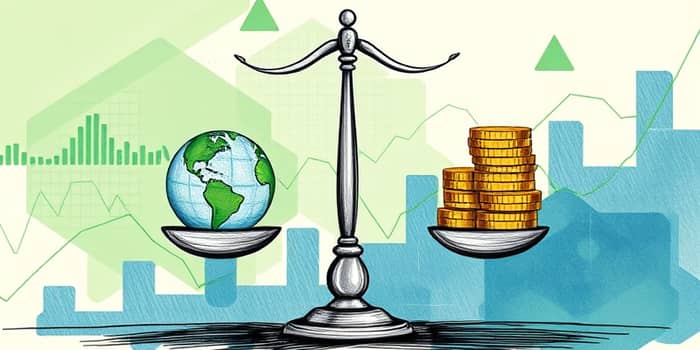For years, the narrative that environmental, social, and governance (ESG) investments yield lower returns has persisted in financial circles and popular discourse. This article draws on the latest data, expert insights, and rigorous analysis to demonstrate that this belief is more myth than reality. By examining industry trends and performance metrics, we reveal how ESG strategies can deliver risk-mitigation and resilience benefits comparable to conventional investments.
The Current ESG Investment Landscape
The global sustainable fund universe encountered its most challenging quarter on record in Q1 2025, reporting record net outflows of $8.6 billion. Despite this setback, total assets under management in ESG funds stood at $3.16 trillion at the end of March 2025, underscoring sustained investor interest.
Regional dynamics varied significantly:
- United States: Tenth consecutive quarter of withdrawals totaling $6.1 billion
- Europe: First ever net outflow quarter of $1.2 billion since 2018 tracking
- Asia (ex-Japan): Redemptions amounting to $918 million
- Canada, Australia, and New Zealand: Contrary inflows near $300 million each
Looking ahead, institutional allocations to ESG assets are projected to surge to $33.9 trillion by 2026, reflecting enduring confidence in sustainable strategies.
Performance Data and Comparative Analysis
Rigorous studies in both public and private markets challenge the assumption of underperformance among ESG vehicles. A major Preqin analysis of over 11,000 private capital funds, including 200+ ESG-focused vehicles, found no statistically significant performance difference between ESG and non-ESG funds. ESG funds recorded an average 13.5% internal rate of return, versus 15.0% for their conventional peers, while demonstrating lower variance in investment returns.
Public markets tell a similarly nuanced story. MSCI ESG Leaders indices posted mixed yet compelling results in January 2025:
- MSCI US Small Cap ESG Leaders outperformed by 41 basis points
- MSCI Emerging Markets ESG Leaders outperformed by 35 basis points
Over extended intervals, the Emerging Markets ESG Leaders Index was the sole equity benchmark to outpace peers over five- and ten-year periods, with annualized gains of 14 bps and 73 bps respectively. Other benchmarks displayed performance close to or slightly below conventional indices, highlighting that ESG integration tracks benchmarks closely over time.
Private vs. Conventional Fund Performance
This comparative snapshot underscores that ESG approaches are not intrinsically inferior but may offer balanced risk-return dynamics.
Investor Perceptions and Business Impact
Despite empirical evidence, a significant perception gap endures. A Preqin survey indicated that 66% of investors see no link between ESG factors and financial performance. Yet, 50.1% acknowledge that strong ESG ratings can yield strong correlation with cost advantages, such as lower capital costs and favorable financing rates.
Moreover, enhanced ESG profiles increasingly serve as a yardstick for operational efficiency, influencing credit spreads, insurance premiums, and stakeholder trust.
ESG as a Value Creation Tool
Beyond risk management, ESG initiatives are leveraged for revenue growth, cost reduction, and stakeholder alignment. Companies with mature ESG practices can benchmark performance, refine sustainability targets, and fortify exit valuations in private equity scenarios. According to Malk Partners, demonstrating ESG-driven operational improvements is vital for unlocking long-term competitive advantages.
Consumer and Market Pressures
Market forces amplify the financial case for ESG. Approximately 76% of consumers would boycott companies ignoring environmental and social responsibilities, highlighting reputational risks for laggards. Concurrently, over 90% of publicly listed firms now issue ESG reports, increasing transparency and enabling investors to make informed decisions.
Carbon Value at Risk Framework
Schroders’ Carbon Value at Risk (VaR) framework illustrates how rising carbon prices impact corporate economics. As carbon costs climb, direct and supply-chain expenses increase, leading to price hikes and lower sales volumes. Different industries experience varying margin pressures under this scenario, emphasizing the need for proactive emissions management.
- Higher carbon prices inflate operational costs
- Companies adjust pricing to preserve margins
- Volume declines subsequently reduce emissions
- Margin impacts vary by sector intensity
Simulations at $100 per ton indicate a potential 30% emissions reduction globally via volume adjustments, underscoring the material impact of carbon regulation on valuations.
Addressing Common Counterarguments
Critics often cite recent outflows, short-term underperformance, regional disparities, and inconsistent ESG definitions as reasons to steer clear. However, these factors are symptoms of a maturing market rather than inherent flaws in ESG investing. As data methodologies standardize and asset managers refine integration techniques, performance divergence narrows.
Conclusion: The Path Forward
Extensive evidence confirms that ESG investments are not systematically inferior to traditional assets. On the contrary, they offer risk-mitigation and resilience benefits that align with long-term value creation. Institutional commitment to sustainable strategies continues to grow, propelled by stakeholder demands, regulatory trends, and evolving market dynamics.
Investors and companies embracing ESG principles stand to benefit from enhanced operational efficiency, improved cost structures, and stronger brand loyalty. Far from yielding lower returns, ESG integration emerges as a cornerstone of modern investment strategies, delivering sustainable performance that withstands market fluctuations and regulatory shifts.
By dispelling the “lower returns” myth, we can chart a course toward a financial ecosystem where profitability and purpose converge, ensuring prosperity for investors, businesses, and society at large.
References
- https://www.keyesg.com/article/50-esg-statistics-you-need-to-know-in-2024
- https://www.morningstar.co.uk/uk/news/264459/investors-turn-away-from-esg-funds-in-record-numbers-in-q1-2025.aspx
- https://www.skadden.com/insights/publications/2025/01/esg-a-review-of-2024-and-key-trends-to-look-for-in-2025
- https://malk.com/esg-forecast-trends-for-2025/
- https://sustainableinvest.com/sustainable-investment-funds-performance-wrap-up-january-2025/
- https://www.institutionalinvestor.com/article/2dg6dknwu3c8joq6uez9c/portfolio/do-esg-factors-help-or-hurt-private-fund-returns-a-new-report-has-an-answer
- https://digitaldefynd.com/IQ/surprising-esg-statistics/










